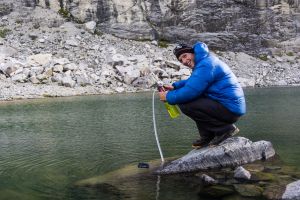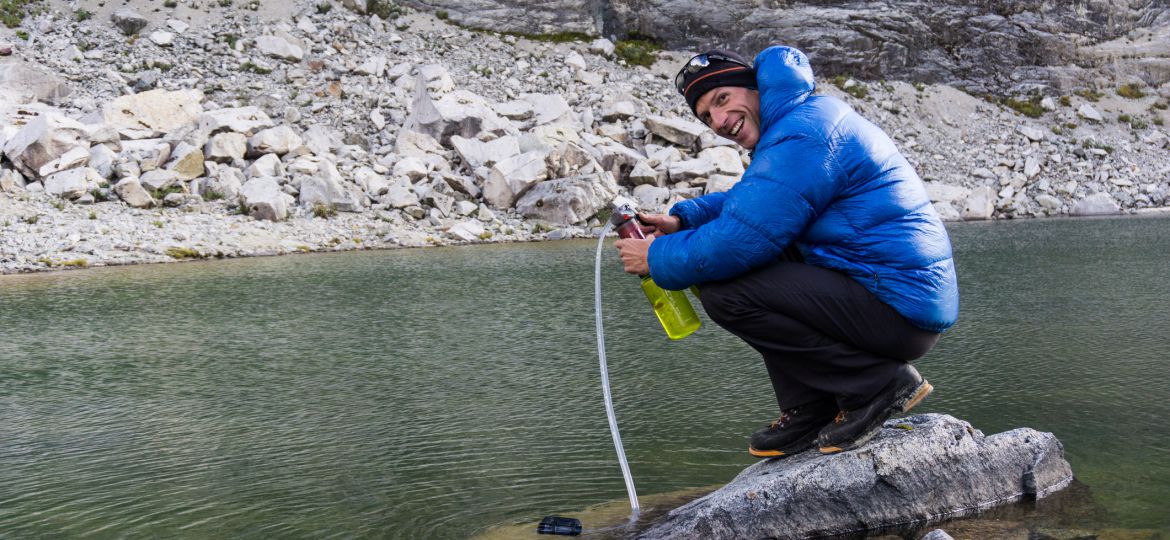
Giardiasis (Giardia lamblia) – Symptoms, Diagnosis & Treatment
Giardiasis is caused by the protozoan parasite Giardia lamblia, which is also known as Giardia duodenalis and Giardia intestinalis. G. lamblia is the most common intestinal parasite in the United States and the most prevalent protozoal intestinal parasite globally.1 Worldwide, Giardia infects more than 280 million people annually.2
In the United States, individuals who are most at risk for giardiasis include outdoor enthusiasts, international travelers, and daycare workers. Globally, giardiasis is more common in children than adults.1
 The Life Cycle of Giardia lamblia
The Life Cycle of Giardia lamblia
Giardia lamblia exists in two forms: a trophozoite and an oval-shaped cyst. The cysts are resilient and survive in the environment. Novel infection occurs after ingesting cysts present in water, soil, or contaminated food.3
Once in the gastrointestinal tract, the cyst undergoes excystation to form the trophozoite. Excystation is initiated in the stomach and completed in the small intestine. The trophozoites can then divide and attach to the small intestine.3
The trophozoites initiate an encystment process to survive if they migrate to the lower intestine for excretion from their current host. During encystment, trophozoites become rounded and produce a cyst wall that protects the cyst as it travels through water and other environments.3
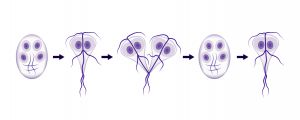 Cyst survival is dependent upon temperature. Some cysts can withstand freeze-thaw cycles. In water temperatures of less than 10 ºC or 50 ºF, cysts can survive for 2 to 3 months. In water temperatures of 21 ºC (69.8 ºF), cysts can remain viable for almost one month. Boiling water at 100 ºC (212 ºF) for at least one minute at sea level to three minutes at high altitude kills the cysts.3,4
Cyst survival is dependent upon temperature. Some cysts can withstand freeze-thaw cycles. In water temperatures of less than 10 ºC or 50 ºF, cysts can survive for 2 to 3 months. In water temperatures of 21 ºC (69.8 ºF), cysts can remain viable for almost one month. Boiling water at 100 ºC (212 ºF) for at least one minute at sea level to three minutes at high altitude kills the cysts.3,4
 Sources of Giardia lamblia Cysts
Sources of Giardia lamblia Cysts
Giardia cysts are always present in municipal wastewater and distributed worldwide in lakes, ponds, rivers, and streams. All surface waters likely contain Giardia, including high-quality water sources with no municipal wastewater discharge.3 Research suggests Giardia can also “catch a ride” in biofilms on microplastics in the ocean.5
Reported levels of Giardia in water sources range from:
- 10,000 to 100,000 cysts/L in untreated sewage
- 10 to 100 cysts/L in treated sewage
- 10 or fewer cysts/L in surface water sources and tap water3
Cysts have also been detected in cisterns and wells, as well as on stainless steel and other surfaces in daycare centers.3
The protozoan parasite Giardia lamblia can infect a variety of animals, including dogs, cats, chinchillas, birds, reptiles, amphibians, fish, ringed seals, beavers, muskrats, voles, mice, shrews, gerbils, rats, deer, llamas, and native marsupials, such as possums.3,6
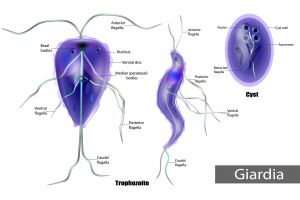 Symptoms of Giardiasis
Symptoms of Giardiasis
Giardia lamblia is highly infectious. As few as ten cysts produced an active infection in a clinical study of male volunteers. The incubation period from cyst exposure to giardiasis ranges from 3 to 25 days.3
Patients with giardiasis can present with an asymptomatic colonization or symptomatic giardiasis, which is characterized by an acute or chronic diarrheal illness.1 A severe infection can lead to serious manifestations, including severe dehydration, growth impairment in children, chronic fatigue syndrome, and weight loss.1,7,8
In symptomatic patients, symptoms may last from 3 days to many months or years. Estimates suggest 4,600 cases of giardiasis require hospitalization each year in the United States. Hospitalized cases are mostly children who are under five years of age, primarily due to dehydration.
Signs, symptoms, and health concerns associated with giardiasis include:
- Abdominal cramps3
- Allergies and acute allergic reactions3
- Arthritis8
- Bloating3
- Cancer8
- Chronic Eosinophilia9
- Chronic Fatigue Syndrome8,9,10
- Cognitive Impairment8,11
- Dehydration1
- Disruption of commensal microbiota8,12
- Failure to thrive8
- Flatulence1,3
- Growth impairment7,11
- Hypokalemic myopathy8
- Impediment of neutrophil chemotaxis9,13
- Increased intestinal permeability (leaky gut)8
- Induction of the apoptosis of enterocytes13
- Irritable Bowel Syndrome (IBS)8,9
- Iron malabsorption3
- Maldigestion and dyspepsia8,13
- Malodorous stools3
- Metabolic abnormalities affecting glucose and insulin levels via the activation of the AKT pathway13
- Mucus depletion in the gut8,12,14
- Nausea8
- Non-progressive retinal changes3
- Nutrient insufficiencies and deficiencies3,7,11
- Ocular and retinal pathologies8
- Pale stools3
- Production of pro-inflammatory cytokines and chemokines, including IL-17A13
- Reduced nitric oxide (NO) production due to the release of metabolic enzymes, including arginine deiminase (ADI) and ornithine carbamoyltransferase (OCT), that deplete arginine9,13
- Shortening of the intestinal villi13
- Steatorrhea with daily losses of over 7 grams of fecal fat3
- Watery diarrhea1
- Weight Loss1,3
- Vomiting3
- Zinc malabsorption8
Please note that asymptomatic infection with Giardia lamblia is an independent risk factor for reduced early life linear growth in infants and children from low- and middle-income countries, according to the Malnutrition and Enteric Diseases (MAL-ED) multicenter study.3,7 Pediatric Giardia infections can also cause allergic reactions, iron malabsorption, non-progressive retinal changes, inflammation of the synovial membranes of major joints, and nutrient insufficiencies.3

Giardiasis Diagnosis
Giardia cysts and trophozoites are shed intermittently in the stool; therefore, detecting them via stool microscopy can be challenging. The sensitivity of stool microscopy significantly increases when collecting three stool samples on different days. Despite the low sensitivity, stool microscopy should always be performed when a Giardia infection is suspected because the differential diagnosis for giardiasis includes many other parasitic diseases.1 Stool microscopy is the current gold standard method for the diagnosis of giardiasis and should continue to be held as the golden standard.15
The Giardia stool antigen detection assay is more sensitive and specific, and typically quicker than stool microscopy. However, the antigen test should never replace stool microscopy.1
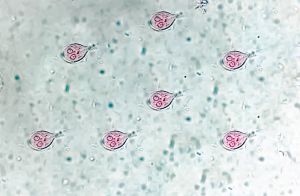 DiagnosTechs includes both tests – stool microscopy and the Giardia lamblia antigen test – with every GI Health PanelTM and Comprehensive Ova and Parasites Panel™. Since Giardia lamblia is highly infectious and easily spread in a household or community environment, all close contacts of the infected individual should also be tested and treated.1
DiagnosTechs includes both tests – stool microscopy and the Giardia lamblia antigen test – with every GI Health PanelTM and Comprehensive Ova and Parasites Panel™. Since Giardia lamblia is highly infectious and easily spread in a household or community environment, all close contacts of the infected individual should also be tested and treated.1
In addition to the stool microscopy and antigen tests, esophagogastroduodenoscopy (EGD) could be considered in cases where giardiasis is suspected but the results are negative. Further work-up is most indicated for patients experiencing persistent malabsorption despite appropriate assessment and treatment. The biopsy obtained during an EGD can show characteristic histologic changes and the presence of trophozoites.1
 The Best Laboratory Test Panels to Diagnose a Parasitic Infection
The Best Laboratory Test Panels to Diagnose a Parasitic Infection
Diagnose giardiasis with one of these DiagnosTechs test panels:
- Regular GI Health Panel™ with GP3x and Calprotectin
- Expanded GI Health Panel™ with GP3x and Calprotectin
- Comprehensive Ova and Parasites Panel™
- Extended Comprehensive Ova and Parasites Panel™
To place a test order, click here. DiagnosTechs will drop ship test kits directly to your patients. You may select this option at the top of the order form.
 Giardiasis Treatment Protocols
Giardiasis Treatment Protocols
Research suggests that a healthy diet with adequate protein and abundant dietary fiber is associated with lower trophozoite burden. Research also demonstrates that a temporary low-fat diet during an acute infection can be therapeutic because a high-fat diet significantly enhances mucosal infiltration of mixed inflammatory cells, exacerbates villus/crypt injury, and increases parasite burden.16
The document Giardia Treatment Protocols, available in your Provider Portal, offers additional pharmaceutical and naturopathic treatment options.
 References:
References:
- Dunn N. Giardiasis. StatPearls [Internet]. February 12, 2024. Accessed July 18, 2025. https://www.ncbi.nlm.nih.gov/books/NBK513239/.
- Pouryousef A, Fararouei M, Sarkari B. Antigen-Based Diagnosis of Human Giardiasis: A Systematic Review and Meta-Analysis. Iran J Parasitol. 2023;18(2):140-154. doi:10.18502/ijpa.v18i2.13180
- GIARDIA: DRINKING WATER FACT SHEET. United States Environmental Protection Agency (EPA). September 2000. Accessed July 21, 2025. https://www.epa.gov/sites/default/files/2015-10/documents/giardia-factsheet.pdf.
- About Giardia Infection. Centers for Disease Control and Prevention. May 3, 2024. Accessed July 21, 2025. https://www.cdc.gov/giardia/about/index.html.
- Beans C. Are microplastics spreading infectious disease?. Proc Natl Acad Sci U S A. 2023;120(31):e2311253120. doi:10.1073/pnas.2311253120
- About Giardia and Pets. Centers for Disease Control and Prevention. March 26, 2024. Accessed July 21, 2025. https://www.cdc.gov/giardia/about/about-giardia-and-pets.html.
- Giallourou N, Arnold J, McQuade ETR, et al. Giardia hinders growth by disrupting nutrient metabolism independent of inflammatory enteropathy. Nat Commun. 2023;14(1):2840. doi:10.1038/s41467-023-38363-2
- Allain T, Buret AG. Pathogenesis and post-infectious complications in giardiasis. Adv Parasitol. 2020;107:173-199. doi:10.1016/bs.apar.2019.12.001
- Fink MY, Singer SM. The Intersection of Immune Responses, Microbiota, and Pathogenesis in Giardiasis. Trends Parasitol. 2017;33(11):901-913. doi:10.1016/j.pt.2017.08.001
- Singer SM, Fink MY, Angelova VV. Recent insights into innate and adaptive immune responses to Giardia. Adv Parasitol. 2019;106:171-208. doi:10.1016/bs.apar.2019.07.004
- Gutiérrez L, Bartelt L. Current Understanding of Giardia lamblia and Pathogenesis of Stunting and Cognitive Deficits in Children from Low- and Middle-Income Countries. Curr Trop Med Rep. 2024;11(1):28-39. doi:10.1007/s40475-024-00314-2
- Fekete E, Allain T, Siddiq A, et al. Giardia and the Gut Microbiota: Dangerous Liaisons. Front Microbiol. 2021;11:618106. doi:10.3389/fmicb.2020.618106
- Klimczak S, Packi K, Rudek A, et al. The Influence of the Protozoan Giardia lamblia on the Modulation of the Immune System and Alterations in Host Glucose and Lipid Metabolism. Int J Mol Sci. 2024;25(16):8627. doi:10.3390/ijms25168627
- Fekete E, Allain T, Sosnowski O, et al. Giardia-induced microbiota dysbiosis disrupts intestinal mucin glycosylation. Gut Microbes. 2024;16(1):2412676. doi:10.1080/19490976.2024.2412676
- Hooshyar H, Rostamkhani P, Arbabi M, Delavari M. Giardia lamblia infection: review of current diagnostic strategies. Gastroenterol Hepatol Bed Bench. 2019;12(1):3-12.
- Allain T, Fekete E, Sosnowski O, et al. High-fat diet increases the severity of Giardia infection in association with low-grade inflammation and gut microbiota dysbiosis. Sci Rep. 2021;11(1):18842. doi:10.1038/s41598-021-98262-8


